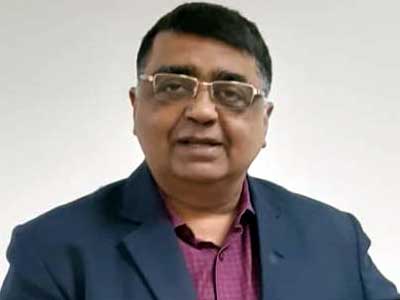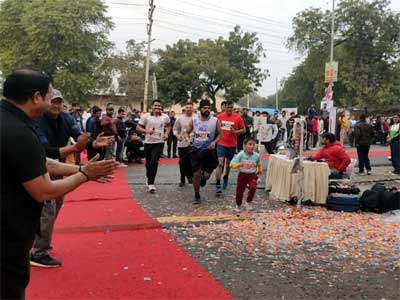Dr Ramesh Chandra Sharma was my elder brother Maxi's classmate at St John's College since 1953. When I got admission to the first year of Intermediate in January 1957 in St John's College, he was doing his MA in History and was a first-year student. Since both my house and his house were in Ghatia Azam Khan, I often used to accompany him while walking to college.
My brother RB Smith was his classmate. He used to address him as 'Ramesh bhai'. I remember very well that Sharmaji always had thick books in his hands, while all of us used to carry only routine books and notebooks. The books in his hands often also contained those books, which were not the ones taught in the university but were considered useful for advanced studies and research.
When I got admitted in BA (First Year) in July 1958, Prof Kanungo, who used to teach us History in Intermediate (at that time Intermediate was also taught in degree colleges), left his service in the college and went to some other college and Ramesh bhai was appointed as a teacher in his place. The college administration told us that he would teach us Indian History (Medieval Period). From that day onwards Ramesh bhai became 'Sharma Sir' for me.
At that time History classes were held in Room No.9 on the first floor of the college building, perhaps they are held there even now. There used to be 60 students in the class, girls used to sit in the first two rows, behind them sat those students who were more interested in studies and were ready to answer quickly when asked by the teacher. In the last rows were those students who were more interested in mischief than in studies. Such students used to come to class only to mark their attendance and to tease classmates, especially female students. Keeping them quiet was not an easy task and some old teachers had experience of teaching them, most of them believed that they neither studied themselves nor allowed diligent students to teach.
Even in such an environment, Dr Sharma's work was far above average. The reason for this was the strictness or firmness in his voice. It is possible that it did not reach some of those sitting in the last row, but those who wanted to study started sitting quietly in the class and also started taking an interest in the lectures due to the teaching style. Within a few days, the class started running peacefully.
In those days, the head of the History Department was an English lady, Ms Gibbs. Based on her experiences, this change in the behaviour of the students was surprising but pleasant for her. Ms Gibbs's voice was not very loud, communication etiquette was her habit. Probably her voice could reach properly only till the first rows. Due to this, the students sitting in the last row kept talking among themselves all the time. The positive assessment of the new professor by the English department head was considered a big achievement at that time.
The educational environment of that time can be gauged from the fact that one had to make several attempts to pass the class. But even after this, when the students could not pass, they used to leave the college and while putting a nameplate at home, they used to consider it their achievement to put Pre Graduate or BA Fail on it.
Many students could not even pass high school despite many efforts, many of them used to get 'High School Fail' written on the nameplate of their house. The logic behind this was that at least people would get to know that 'they have studied till high school'. These people believed that passing or failing is in the hands of God.
Generally, the reason for students failing was Maths and English subjects. I remember that since starting teaching, Dr Sharma was an inspiration for the brilliant students, while the unruly ones also accepted him as a polite teacher. Immersed in books.
When the memorial book of my father, the late Thomas Smith, a journalist, whom the journalists of Agra used to call 'Papa' like me, was published in 1997, Dr Sharma's important cooperation and contribution were there in it. It is the result of his hard work and deep study that many articles published in the book were much discussed and are considered a guide for researchers of history even today.
I remember that when Dr Sharma prepared a research paper on the British Governor General Lord Charles John Canning, he brought it to me and told me that it is written in English language, after reading it, I should make any changes or improvements in its language without hesitation. This request of Dr Sharma made me feel very proud, a very reputed teacher of his time came to one of his former students and asked him to make improvements in his research paper, this was an event that boosted my self-confidence and I will never forget. I gladly did that work, as I have been doing in the research papers of other researchers, but in this case, the experience was a little different as compared to others.
Initially, I was not very interested in doing a PhD, but with time the importance of a PhD in higher education kept on increasing. So, when it became necessary to do PhD, despite my reluctance, I prepared the thesis. Despite this, I still believe that, among the thesis, there are very few exceptions that provide new information, in most of them the information given in old and other research papers is presented in a new way. Later, when the pressure on me to do PhD increased even more, then despite my reluctance, I completed the thesis and typed it myself in two months and also obtained the doctorate. But this entire process was full of many new experiences for me. I still believe that doing PhD by doing research may increase some respect but it is not necessary that it also increases scholarship. I believe that since 1960, the trend of people towards doing PhD and getting others to do it has increased with unprecedented speed and it is continuing unabated. But even in this new trend, there are researchers like Dr Sharma who are examples in themselves, whose every research thesis is known for its originality and fullness of new information. Now the level of PhD has fallen a lot, many examples of doing research work sitting at home are found.
I do not consider it very relevant to have a deep discussion on the state of examinations but I believe that 70 to 80 per cent marks can be managed by the manipulation of the students themselves and their parents. By mentioning the examinations, I may have deviated from my main topic, but it is relevant in the context of Dr Sharma, who not only helped students during his academic years but also after that, I do not remember him ever showing any partiality or discrimination in sharing his store of knowledge with anyone.
Now it is considered that those who do a PhD have a tradition of asking for money from researchers in return for help, but Dr Sharma was an exception and example in this matter, I do not remember anyone daring to say about him that he asked for money in return for PhD. This is the reason that whoever came to him took full advantage of the store of knowledge and went away with his head bowed in reverence.
Before retiring, Prof Sharma handled the research projects of 20 researchers, however, he published a total of 75 research papers in his lifetime. One of his popular books 'Agra-Madhyakali eva Adhunik' is also mentioned in the research context.
While searching my memories, I remember that in 1963 I was appointed as a teacher in Balwant Rajput College, when I told him about this, he was very happy. It seems like yesterday to me, when I used to see him passing through the road in front of my house. Usually, he used to visit the house of Dr Harihar Nath Tandon, a famous Hindi writer and a scientific researcher of Varta literature of Brij. Tandon sahab was the head of the Hindi department of St John's College, so it was normal for Dr Sharma to visit him, but later when Harihari Nathji was no more, he continued to visit his son Dr Sanjay Tandon. Probably the reason for this must have been that Dr Tandon also had an interest in promoting the folk literature of Brij Mandal like his father.
Dr Sharma, being curious about my father late Thomas Smith, who was a famous journalist of his time and was known for writing investigative reports and articles on the history of Agra, expressed his desire to meet him. Since our houses were in the same locality (Ghatia Azam Khan), I said that you can come whenever you want. Father is sociable and he will be very happy to meet you. On this Rameshji started coming to our house, once this trend started, it kept on increasing. Father used to call Dr Ramesh 'Ramesh Babu', while Dr Ramesh used to call father 'Papa ji' like me. Actually, by then Father had started being honoured with the honour of 'Papa' first among the family, then among the journalists and later in the public life of Agra.
Thomas Smith was a reporter who believed in wandering, he used to discover something new. This increased further after meeting Dr Sharma. Though many newspapers kept publishing something new, a large number of readers had formed who read his articles and reported in the 'Statesman' published from then Calcutta, now Kolkata and Delhi.
Due to Dr Sharma, history started being included accurately in the reports, references started being presented with more relevance. Since it was not the internet era and computers were not in vogue, searching for each reference was a very laborious job. Along with this, typing a report or article was also no less challenging. If there was even a slight mistake in the dash, semi-column, inverted comma, underline, footnote etc., then the whole sheet had to be typed on the Remington machine.
While Thomas Sahab would go to monument sites and collect information and read the bills, Dr Sharma, along with inspecting the location, would meet people and collect proverbs etc. about a particular place. If there was any book etc. about a particular place, he would find it too and help Smith Sahab. Refreshing the history lost in the abyss of time
This team of historians and reporters collected most of the information which had been left far behind by the cycle of time, or rather, had been forgotten. They travelled on many roads including Hathras Road, Jagner Road, Gwalior Road and Mathura Road and did ground exploration by taking footpaths. Ignoring the lack of government and private vehicles, UP Roadways buses were used extensively in these exploration trips. Remembering the condition of UP Roadways and the state's roads till thirty years ago, these trips seem like adventure expeditions.
As far as Dr Sharma's family relations are concerned, they have continued since they began. His children were born in front of me. His son Anil and daughter Nithi are like my children and address me as 'Chachaji', which is a matter of pride for me. My wife and I were invited to every family function. When I had to go to Bangalore 15 years ago, I stayed with his elder son Anil, who was working for a corporate company in Bangalore at that time and lived in a nice flat. There is a long series of memories. My father Late Thomas Smith and Dr Sharma's father Late Ambika Charan Sharma were close friends. They were of the same age. This friendship which started at the age of 25 continued unabated. Both were popular members of the group of senior citizens of Paliwal Park. Now I am going to turn 85 in a few days.
Dr Sharma was three years senior to me. I always considered him my teacher and gave him the same respect. I consider the purpose of this article to be to pay tribute to him, which is also my indirect duty as a writer and journalist.
(Author is Former Vice Principal of RBS College at Dr Bhimrao Ambedkar University of Agra)












Related Items
Women’s College wins in Basketball, AMU wins in Volleyball
Women’s College hosts sports events celebrating ‘Fit India Week’
National Energy Conservation Day observed